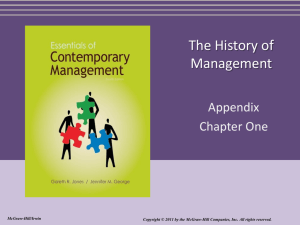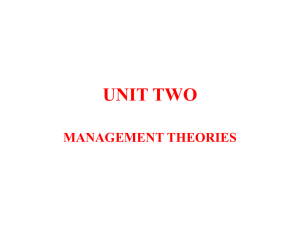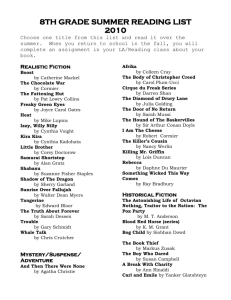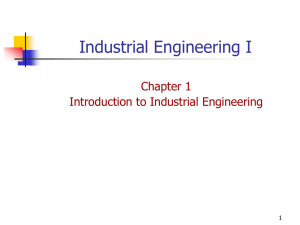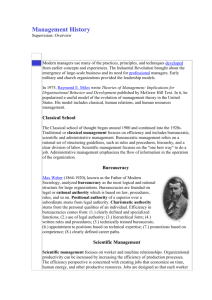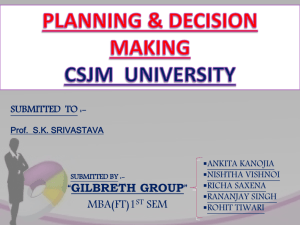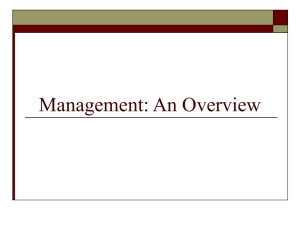Seminar One
advertisement
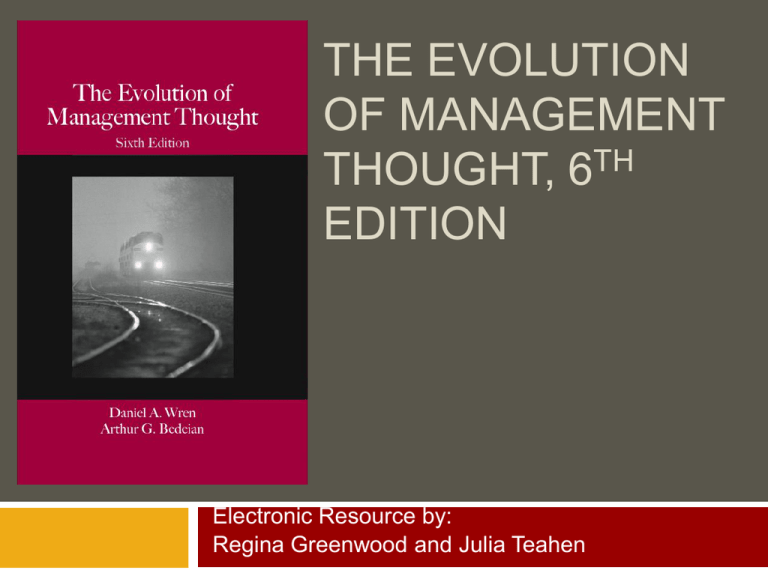
THE EVOLUTION OF MANAGEMENT THOUGHT, 6TH EDITION Electronic Resource by: Regina Greenwood and Julia Teahen CHAPTER EIGHT Spreading the Gospel of Efficiency Others Involved in the Scientific Management Movement Carl Georg Lange Barth Henry L. Gantt Frank Gilbreth Lillian Gilbreth Harrington Emerson Morris Cooke Carl Georg Lange Barth (1860-1939): The Most Orthodox Carl Barth was a mathematician who helped Taylor with some metalcutting experiments. He was probably a major influence in the writing of the “official” biography of Taylor. Assisted in installing scientific management in various companies. Carl Georg Lange Barth One company was the Franklin Motor Car Company which was noteworthy because it preceded Henry Ford’s moving assembly line. Note: Scientific Management lost its importance to the auto industry once the assembly line was implemented. Work was placed on a belt and individuals were no longer able to influence their output and therefore their reward. Carl Georg Lange Barth Barth created a “slide rule” for every machine for scientific measurement. Personal note: Barth would not let his son date because it would detract from his scientific work. His son married after Barth’s death. Henry L. Gantt (1861-1919) The Most Unorthodox Gantt’s early work paralleled Taylor’s in his belief about worker selection, incentives to reward performance, mutuality of interests, etc. Taylor and Gantt admired each other’s work. Gantt was a prolific writer – over 150 titles. Henry L. Gantt Henry L. Gantt: Task and Bonus System Implemented task work with a bonus to stimulate performance. When he discovered that this provided little incentive beyond meeting the standard, he modified the payment plan. He influenced Taylor because Taylor believed Gantt’s plan was better. Rewarded supervisors when their employees came up to standard (rewarded development of employees). (Based on E. P. Earle’s work) Emphasized importance of morale, training, and development of employees. Simplified Gantt Chart The Gantt Chart The Gantt Chart The Gantt Chart steadily evolved into a valuable tool for planning and controlling work. Widely used during World War I. Became an international management technique. A forerunner of subsequent planning and controlling techniques such as major milestones, PERT & CPM. Other Gantt Ideas The New Machine – a group headed by Gantt to promote the idea that engineers should be industrial leaders. Social responsibility – Gantt’s concern that business should not lose sight of its service role in the economy. Frank & Lillian Gilbreth Partners for Life Frank – Worked in the construction trades and called his job design “motion study.” Independent of, but influenced by, Taylor. Lillian – our “First Lady of Management” and “First Lady of Engineering” for her accomplishments with her husband as well as after Frank’s death. Frank Gilbreth (1868-1924) Frank Gilbreth Refused a place in MIT to work as a laborer. His first job was apprentice brick layer. He was able to lay 2700 bricks per day compared to others who were laying an average of 1000 per day. Motions to lay a brick reduced to 4 from 18. Today, union rules only allow workers to lay between 900 and 1100 bricks per day. Bricklaying Typical building site in Boston before Gilbreth’s new methods are applied With Gilbreth’s new methods, bricks are arranged to be grabbed easily, right side up. Gilbreth Patent Scaffold This invention eliminated a lot of stooping by keeping the bricklayer at the same distance from the top of the growing wall. The scaffolding was the first in Gilbreth’s attempts in reducing motion and fatigue in workers. Gilbreth Patent Scaffold Frank’s Construction Business Boston was in a period of rapid growth…during the building age of the country. He used advertising to promote contracts and the need for workers which was uncommon at this time. Within six years from the start of his business, he was one of the most important men in construction in Boston. Frank’s Construction Business Building constructed by Frank at MIT in record time Lillian Gilbreth (1878-1972) Lillian Gilbreth Earned undergraduate and graduate degrees from the University of CaliforniaBerkley. Enrolled in a Ph.D. program at the University of California. Studies were interrupted by her family who decided that Lillian should travel abroad – chaperoned by Frank Gilbreth’s cousin, Mimi. The Partnership Frank and Lillian Gilbreth Soon after their marriage, Lillian realized that she would not fill the traditional role of “wife.” Lillian followed Frank to work and began to learn the business. The Gilbreth Children Part of the family vacation home on Nantucket Frank decided that twelve children is the right number for a family – 6 girls and 6 boys. According to Frank, with proper planning, the children would not interfere with their work. Frank and Lillian achieved both goals. However, their daughter (Mary Elizabeth) died at the age of six from diphtheria. The Gilbreth Family The Gilbreth Children at their summer home in Nantucket The Gilbreth family at their summer home in Nantucket, 1923—Left to right, Frank (Sr.), Frank (Jr.), Bill, Fred, Dan, Jack, Bob, Jane, Lil, Martha, Ernestine, Anne, and Lillian Gilbreth. (Not pictured is Mary Elizabeth, who died at the age of six.) The Gilbreth Family Gilbreth Children Books The Gilbreth children tell the story of growing up in this family in three books. Lillian’s Dissertation Lillian finished her thesis in 1912. However, the University of California would not lift the residency requirement so she could not graduate. Her thesis was eventually published in book form by Sturgis and Walton in 1914 under the name L.M. Gilbreth (so one could not distinguish that is was written by a woman) The book stands in management literature as one of the earliest contributions to the study of the human element at work. Lillian’s Ph.D. Frank found Brown University where Lillian could complete her Ph.D. degree and still care for the children Frank arranged that Lillian could attend courses in one specific room from which she could look out the window and watch their children She completed a 2nd dissertation “Some Aspects of Eliminating Waste in Teaching” She graduated in 1915 Lillian Gilbreth Gilbreth’s Motion Study “Our duty is to study the motions and to reduce them as rapidly as possible to standard sets of least in number, least in fatigue, yet most effective motions” (Gilbreth, 1911, p. 3) Frank Gilbreth Therbligs Frank developed a list of seventeen basic movements to aid him in analyzing motion. Each movement was called a “therblig.” These fundamental movements, which could not be broken down into other motions, gave Frank a way to accurately analyze elements of any movement a worker may make. Can you determine the origin of the term “therblig?” Fundamental Hand Motions - Gilbreth Therbligs also had colors and symbols Motion-Picture Camera Using a motion-picture camera, Frank was able to capture each movement of a job on film so he could easily analyze each motion. To save film, he changed the camera aperture to record 4 movies on one reel of film. Gilbreth Motion Study Applied Motion Study The Gilbreths also used lights and time-lapsed photography in their motion study. This use of light and photography was called the “chronocyclegraph method of recording.” This device recorded a path of motion a worker used to complete a job. The device consisted of a small electric light which was attached to a finger or another moving part of the body. The film was exposed during this time period and recorded each line of light. Cyclegraph Chronocyclegraph method Chronocyclegraph method Gilbreths influence art Artist Mike Mandel used the Gilbreths’ techniques to create photographs for his art exhibits. His work, with acknowledgement to the Gilbreths, is presented in his 1989 book, Making Good Time. Applied Motion Study The Gilbreths conducted motion studies with typists, surgeons, nurses, and sports. The photographs to the left were from an exhibit of the Gilbreths’ work at the Smithsonian. Applied Motion Study – Typing for Remington Typewriter Co. Applied Motion Study - Surgery Applied Motion Study – Surgical Sewing Fatigue Studies Through proper rest breaks, fatigue could be reduced. Suggestions: Reduced working hours so that employees had sufficient time to recover and be prepared for the next working day. Longer lunch periods, coffee or tea breaks. To make rest breaks more attractive to employees, the Gilbreths suggested that organizations could provide proper reclining chairs, lunch rooms, rest rooms, or other entertainment. Home Reading Box Movement The Gilbreths also worked to establish libraries at each job site to check out material to read at home or during breaks. Ergonomics Frank Gilbreth is often called the “Father of Ergonomics.” The Gilbreths pioneered the use of devices, such as adjustable chairs and improved workstations, to ease strain on the body and reduce injuries. Adjustable chair designed by F. and L. Gilbreth The End of the Partnership Frank died in 1924. Lillian continued to work even though it was difficult for a woman and to make a name for herself without Frank. She spent the rest of her life (into her nineties) consulting and speaking all over the world. Lillian Gilbreth Some Lillian Gilbreth Honors Only woman awarded the Gilbreth Medal (named for Frank and Lillian). Only woman awarded the Gantt Gold Medal. Only woman Awarded the CIOS Gold Medal. Earned over 13 graduate degrees between 19281952 in addition to her first 3 degrees. US Postage stamp issued in her honor in 1984 Harrington Emerson (1853-1931): Efficiency through Organization Harrington Emerson Emerson worked for the most part independently of Taylor but they corresponded and he was aware of Taylor’s ideas. His experience as a consultant on railroads provided his qualifications at the Eastern Rate Case regarding the savings possible if scientific management methods were installed. He founded Emerson Consultants which exists today. Harrington Emerson’s Ideas Lack of organization was a major problem. Emerson proposed the line-staff organization as a way of bringing staff knowledge to assist the line managers. His line-staff idea was similar to Taylor’s desire to use the knowledge of functional foreman, but an improvement since it did not split the chain of command. Harrington Emerson’s Ideas He took Taylor’s idea of setting performance standards and applied this to cost accounting. Standards should be established for what the costs should be, rather than estimating costs from previous records. Emerson provided 120% wages for 100% performance (the standard) and that increased if the worker produced more. He wrote Twelve Principles of Efficiency in 1913. Of Emerson’s numerous “principles,” clearly defined ideals (objectives), participative decision making, and the proper use of staff stand out as the more unique of his ideas. Morris L. Cooke (1872-1960) The Gospel in Nonindustrial Organizations Worked closely with Taylor and became one of the four individuals Taylor considered his disciples. Morris L. Cooke Gantt, Barth, and Hathaway were the others Extended gospel of efficiency to education and government. Morris L. Cooke Taylor sent Cooke on various consulting assignments: In education – he felt that college administration was inefficient. In government – Cooke became Director of Public Works for the City of Philadelphia and successfully implemented scientific management. Cooke, as Director of Public Works for Philadelphia, was instrumental in making today’s city waterfront. Morris L. Cooke Used a stenographic transcript of Taylor’s talks at Boxly as the basis for his proposed book, Industrial Management. His book became Taylor’s Principles of Scientific Management. Taylor assigned all royalties to Cooke. Cooke would write other books, particularly in the field of public administration. Morris L. Cooke – Later Work Interested in leaders of organized labor working within scientific management ideas. Suggested that management needed to “tap labor’s brains.” Worked with labor leaders in gaining better feeling about unionmanagement cooperation. Served Presidents F.D. Roosevelt and Harry Truman in government positions. Courtesy of the Pennsylvania Rural Electric Association Three Other Scientific Management Contributors Henri Le Chatelier (1850-1936) M. Clarence Bertrand Thompson (1882-1969) Horace K. Hathaway Henri Le Chatelier (1850-1936) Henri Le Chatelier French Engineer Le Chatelier helped to bring Scientific Management to France Stated that Shop Management was a more important work than the Origin of Species. M. Clarence Bertrand Thompson (18821969) Worked in France until 1948. Received the Legion of Honor for keeping French factories alive during the War. Unlike Taylor, he believed Unions were important in instituting Scientific Management Principles. After he left France, he received a Ph.D. (around the age of 80) in biochemistry and worked in cancer research until he died, close to the age of 90. Horace K. Hathaway Instituted Scientific Management principles into a whole system including accounting, planning, organization, and production scheduling His plan was essentially an ERP system Summary Scientific Management reached maturity in the 1920s. The movement was assisted by Taylor’s disciples Carl Barth, Henry Gantt, and Morris Cooke. Other notable contributors to the evolution of Scientific Management were Frank and Lillian Gilbreth and Harrington Emerson.

